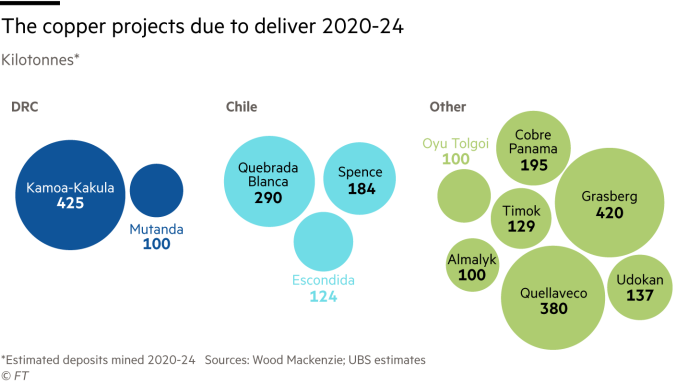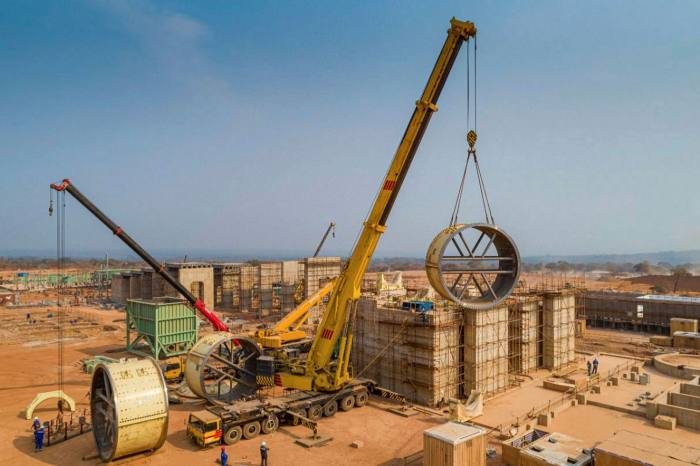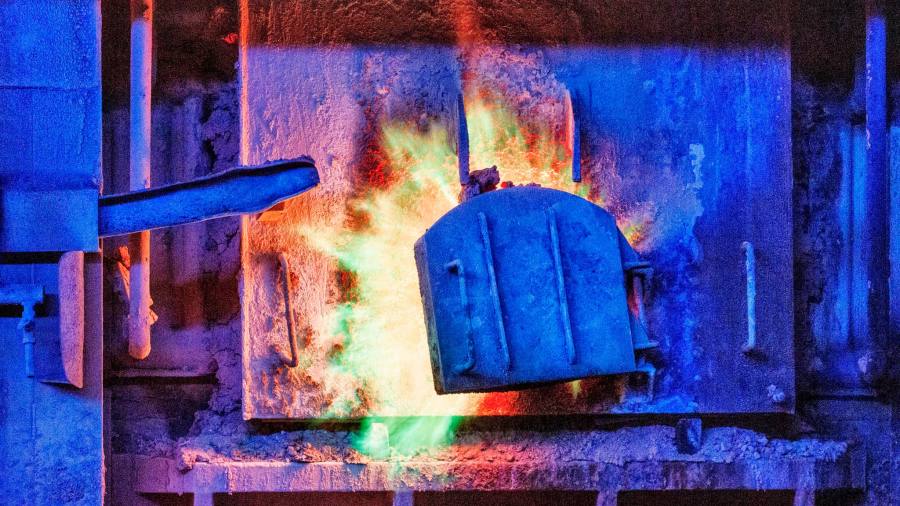Kamoa-Kakula in the Democratic Republic of Congo is a rare commodity in the modern resources industry: a high-grade copper mine that one day could produce enough metal to satisfy more than 5 per cent of China’s annual demand.
Surrounded by small villages, the mine employs around 7,000 workers and has its own road for trucks to carry rock to a nearby smelter. The company is also upgrading a 40-year-old hydropower station on the Congo River to provide electricity to run the mine.
The first phase of the $2bn project began operating in May, more than four years after the last big copper mine of similar scale, MMG’s Las Bambas, in Peru, came online. Despite these projects, years of belt tightening mean the pipeline of new copper projects is running dangerously thin just as demand for the metal — used in everything from wind turbines to electric vehicles — is set to soar.
Governments around the world are launching huge stimulus programmes focused on job creation and environmental stability.
The coming together of such demand and potential supply shortages has many people on Wall Street, and in the City of London, hailing the arrival of a commodities supercycle and asking if copper is set to become the new oil, a strategically important raw material.
“We see potential for a multi-decade commodity cycle ahead driven by decarbonisation of the global economy and shift to cleaner energy,” says Tal Lomnitzer, a senior fund manager at Janus Henderson. “It has more legs to it than the China boom of the early 2000s.”
Commodities have enjoyed a dizzying run over the past year, initially on the back of strong demand from China, and more recently other big economies. Supply disruptions have provided further impetus. Copper, iron ore, the key ingredient needed to make steel, palladium and timber all hit record highs in May, while agricultural commodities including grains, oilseeds, sugar and dairy have also jumped.

While there is no agreed definition of a supercycle, it has been commonly used to describe a period where commodity prices rise above their long-term trend for between 10 and 35 years. These cycles are typically triggered by a structural boost to demand that is large enough to register globally and to which supply is slow to respond, according to Capital Economics.
There have been just four sustained periods of above-trend commodity prices over the past 120 years. The first came with the emergence of the US as an economic powerhouse in the 1880s and the last with China’s rapid industrialisation in the early 2000s.
“Most people in commodities markets thought we were never going to see another Chinese urbanisation story. But it is now pretty clear that the green capital expenditure story is going to be bigger and multiples bigger because it is global”, says Ben Cleary, a partner at Tribeca Investment Partners, a boutique fund management group based in Australia.
“I also don’t think the China green capex numbers are fully appreciated,” he adds, “it’s $2tn a year for 40 years to get to net zero carbon. The numbers are mind blowing.”

The green effect
It is not a universal sentiment. Many economists believe the current boom in commodity prices is cyclical rather than structural and can be explained by strong Chinese demand, a post-pandemic economic recovery in Europe and the US overlaid with supply chain disruptions. They expect the rally to peter out as China — still the world’s biggest buyer of commodities — tightens credit.
Indeed some raw materials have already fallen in price. Iron ore is down 10 per cent from its recent record high of $233 a tonne in May as Beijing has moved to cool runaway prices.
“Commodity prices have rallied because demand is so strong,” says Ric Deverell, chief economist at Macquarie in Sydney. “But in large parts that is a cyclical rebound from a very large recession. And, of course, it has been turbocharged by stimulus.”

Sceptics are also quick to point out that not all commodities are in short supply. A case in point is oil, where Opec and its allies have yet to fully unwind the huge production cuts enacted in April 2020.
“When we are talking about a supercycle, we are talking about something bigger and that has to involve the major commodities, such as oil and iron ore,” says Mark Williams, chief Asia economist at Capital Economics. “And, for those commodities, the demand outlook is weaker.”
However, when it comes to copper and other metals linked to investment in green technology, such as cobalt and nickel, even sceptics accept the outlook is bright, because supply is constrained and demand is set to accelerate.
“In terms of trying to decarbonise the world, the only possible way we can do that is through copper. There’s really nothing else that can conduct electricity as well,” says Jeff Currie, head of commodities research at Goldman Sachs and one of the strongest proponents of the idea that we are in a new supercycle.

“That’s why we say it is as strategically important as oil, because if you want to decarbonise transport and industrial fuels through electricity, you are going to need copper,” he adds, “and a lot of it.”
An electric vehicle contains 5 times more copper (60-83kg) than a car fitted with an internal combustion engine, according to Goldman, while a 3-megawatt wind turbine uses up to 4.7 tonnes of the metal.
Goldman is not alone in forecasting strong demand growth. To achieve net zero emissions by 2050, the International Energy Agency says the total market size of critical minerals such as copper, cobalt, manganese and various rare earth metals will have to grow almost sevenfold between 2020 and 2030.

“Every supercycle in commodities has been tied to redistribution policies,” says Currie. “What’s the redistribution story this time around? Tackling income inequality. And it is pretty clear we are going to tackle it the same way Franklin Roosevelt did in the 1930s, through green capex, just like the Hoover Dam.”
Currie points to US President Joe Biden’s jobs plan and Europe’s Green New Deal as evidence for that view. But just as demand is expected to take off, the copper market is arguably the closest it has ever been to peak supply, due to big miners curtailing investment in new projects. That trend started around seven years ago, after a brutal downturn in commodity markets pushed many miners with bloated balance sheets and unsustainable dividend policies close to financial ruin.
“Mining companies are likely to continue to prioritise capital returns and balance sheet strength over investment in long-lead-time, capital-intensive growth projects,” says Christopher LaFemina, an analyst at Jefferies. “The economics of these projects are moving targets that are in many ways beyond the control of the mining companies.”

Fall off in capital spending
Robert Friedland started searching for copper in the DRC more than a quarter of a century ago. Many people thought he was crazy. At the time the country was in the midst of a brutal war.
“Our team of geologists worked 15 years in the bush to find this deposit against a great deal of scepticism,” Friedland says of the Kamoa project, a joint venture involving his company Ivanhoe Mines, China’s Zijin Mining and the government of the DRC. “It is unquestionably the largest discovery in the history of the African copper belt.”
While the copper market is relatively well supplied for the next couple of years, thanks to developments such as Kamoa and Quellaveco — the $5bn Peruvian copper mine Anglo American expects to bring online in 2022 — beyond that the pipeline of new projects looks thin.

“People look at the supply numbers, but they don’t filter in how difficult it is to get that supply,” says Farid Dadashev, co-head of European metals and mining at RBC Capital Markets. “The last time the copper price was high in 2011 and 2012 there were a couple of new projects in the market but they were all delayed and the capital expenditure was extremely high.”
After blowing billions of dollars in the last commodity boom on overpriced deals and over ambitious projects, the mining industry has dramatically scaled back spending and focused on returning cash to shareholders, who have now become used to receiving fat dividends from the sector.
“All the major producers have been returning capital for the best part of six or seven years with a gun to their head from shareholders who don’t trust their ability to reinvest profits into growth,” says Cleary from Tribeca Investments.
As a result, global mining and smelting capital expenditure, which peaked at $220bn in 2012, only reached half that level last year, according to data from Wood Mackenzie. Exploration spending has also dropped sharply from $35.7bn in 2012 to just over $10bn last year, according to Tribeca.
In spite of rising commodity prices — copper has almost doubled in the past year, recently hitting a record above $10,500 a tonne, although it has since slipped almost 5 per cent — miners are either unwilling or unable to sign off on new copper projects.

Unless that changes, Goldman sees an annual supply shortfall of 8.2m tonnes emerging by 2030. To put that figure in perspective, last year global refined copper production was 23.5m tonnes.
It is becoming increasingly difficult to find high grade copper projects in safe mining jurisdictions.
Ivan Glasenberg, the long-serving boss of miner and commodity trader Glencore, told the Financial Times recently that the copper price would need to rise 50 per cent to meet projected demand from the global green revolution. “You will need $15,000 copper to encourage a lot of this more difficult investment,” he said. “People are not going to go to those more difficult parts of the world unless they are certain.”
It is not just in the more difficult parts of the world where there are problems. Proposed tax changes in Chile and Peru — gripped by the most divisive presidential election in recent history — could make it very difficult for foreign miners to invest in the world’s two biggest copper producing nations.
“Fiscal uncertainty is likely to deter investment and impact future supply,” says Liam Fitzpatrick, an analyst at Deutsche Bank, who has identified $50bn of projects in Chile, Peru and Zambia that are up for approval over the next decade but could be delayed.

Ageing mines and declining ore grades present other challenges for the mining industry. These are particularly pronounced in Chile, where state-owned Codelco — the world’s biggest copper miner — needs to spend $35bn between now and 2030 to keep annual output steady at 1.6m to 1.7m tonnes.
It can take up to 10 years to develop a new copper project, assuming all the approvals are in place. So even if the mining industry, swayed by higher prices, decides to open the purse strings now, it may already be too late to prevent large supply deficits from opening up later in the decade.
“If we knew how hard it was going to be to find a major copper system and bring it into production with hydroelectricity in the Congo,” says Friedland, “I can assure you we would have given up.
“That’s the problem with mineral exploration,” he adds, “very few efforts come to fruition”.
Aluminium as an alternative
Not everyone is convinced that copper is set for a supercycle. Julian Kettle, vice-chair of metals and mining at Wood Mackenzie, says higher copper prices will incentivise substitution towards aluminium, which has a lower conductivity than copper, but is much lighter.
In May, London-listed Tirupati Graphite said it had developed a graphene-aluminium composite material that it said had conductivity similar to copper. The company is working with Rolls-Royce on using it to replace copper in thermal, power and propulsion systems, according to a person familiar with the company.
During the last China-driven commodity supercycle, Kettle estimates the copper market lost 2 per cent, or between 400,000 and 500,000 tonnes per year, of demand due to aluminium substitution when prices rose above $6,000 a tonne.

“If raw materials prices are rising quickly, you look at opportunities for thrift,” he says. “It’s back to the law of physics: if the supplies aren’t there, then you cannot consume. The notion the price will go to fanciful numbers on a sustainable basis . . . that [scenario] tells the market you can’t deliver supplies and consumers will look elsewhere.”
But even Kettle concedes that the outlook for the copper market is relatively bullish. It needs to double in size by 2040 if the world is to meet the targets set out in the Paris climate agreement. “If there is one commodity where you will see supercycle characteristics it is copper. But the fundamental drivers aren’t there just yet,” he adds.
Back in the DRC, Ivanhoe Mines has begun searching for another big copper discovery on a parcel of land close to Kamoa-Kakula. And this time the work of its geologists is drawing attention rather than scepticism from big western miners, as well as sovereign wealth funds and international financial institutions, according to Friedland.
“Kamoa wasn’t just the discovery of a mine,” he says. “It was the discovery of a whole new mineral province.”
